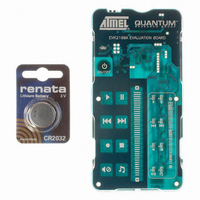EVK2160A Atmel, EVK2160A Datasheet - Page 39

EVK2160A
Manufacturer Part Number
EVK2160A
Description
KIT EVAL FOR AT42QT2160-MMU
Manufacturer
Atmel
Series
Quantum, QTouch™r
Specifications of EVK2160A
Sensor Type
Touch, Capacitive
Sensing Range
8 Buttons/Keys, Slider
Interface
I²C
Voltage - Supply
1.8 V ~ 5.5 V
Embedded
No
Utilized Ic / Part
AT42QT2160
Silicon Manufacturer
Atmel
Silicon Core Number
AT42QT2160-MMU
Kit Application Type
Sensing - Touch / Proximity
Application Sub Type
Capacitive Touch
Kit Contents
Board CD Docs
Rohs Compliant
Yes
Lead Free Status / RoHS Status
Lead free / RoHS Compliant
Sensitivity
-
Lead Free Status / Rohs Status
Supplier Unconfirmed
Other names
427-1141
Available stocks
Company
Part Number
Manufacturer
Quantity
Price
Company:
Part Number:
EVK2160A
Manufacturer:
Atmel
Quantity:
135
9. Getting Started With the QT2160
9.1
9.2
9.3
9.4
9.5
9502A–AT42–07/08
Using the I
Establishing Contact
Writing to the Device
Reading From the Device
Keys
2
C-compatible Bus
The QT2160 is an address-mapped part. All commands and data transfers consist of reads
from, and writes to, memory locations.
To establish that the device is present and running, write a zero to it (see
a single byte (see
the device is present and running.
A write cycle to the device consists of a start condition followed by the
the device (see
will start. This address is then stored as the address pointer.
Subsequent bytes in a multibyte transfer will be written to the location of the address pointer,
location of the address pointer +1, location of the address pointer +2 etc. This ends with the stop
condition on the
pointer.
It is possible to stop the write after the address pointer is sent if no data is required to be written
to the device. This is done when setting the address pointer for reading data.
A read cycle consists of a start condition followed by the
(see
pointer set by the last write operation. The address is internally incremented for each byte read
during a multibyte read.
The stop condition at the end of the transfer causes the internal address pointer to revert to the
value written during the last write operation. This means that if a set of data bytes needs to be
read many times (such as the status bytes) then it is not necessary to keep sending an address
pointer. It can be set to the first location and multibyte reads will always then start there.
The default setting of the QT2160 is for 16 keys with AKS disabled. This will be the default
setting when the device first powers up. A coin placed over any key can be used to pick up the
burst signal to see the activity on the keys as explained in Section 3 of the application note
“Secrets of a Successful Touch Sensor Design" which can be downloaded from the Quantum
area of the Atmel website.
The CHANGE line will go low indicating there is new data to be read. Reading the status bytes
(address 2...6) will cause the CHANGE line to go inactive, as the data has been read.
If a key is now touched, the CHANGE line will go active again, indicating that there is new data
again. The CHANGE line will remain active until the status location containing the status for that
key is read. If the CHANGE line does not go low then it is likely the sensitivity of the key is not
high enough. The burst length should be increased to increase the sensitivity.
Section
6.1). Bytes can then be read starting at the location pointed to by the address
Section
I
Section
2
C
-compatible bus. A new write cycle will involve sending another address
6.1). The next byte is the address of the location into which the writing
9.4). This byte should be the ID of the device (0x11). If this is the case
I
2
C
-compatible address of the device
I
2
AT42QT2160
C
Section
-compatible address of
9.3). Now read
39













